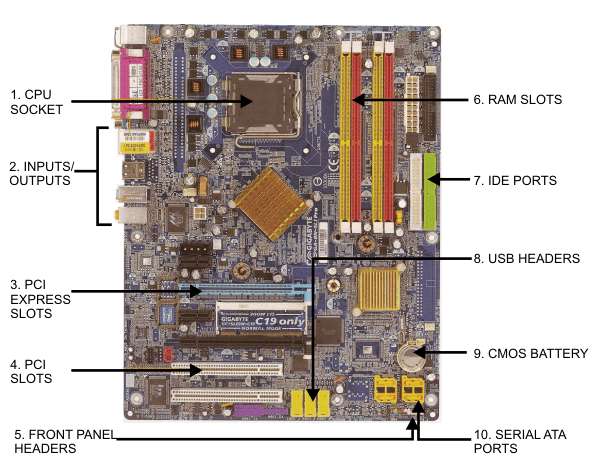|
1. CPU Socket.
The Central Processing Unit fits into this socket. This is the component
that processes all the data from the software, hardware and
keyboard/mouse. Two main manufacturers are INTEL and AMD. The CPUs tend
to become extremely hot when in use and usually have a large fan fixed
on top, to cool them down.
2. Inputs and
Outputs. These are a range of connectors at the back of the
computer unit. They include USB ports for the mouse and COMs ports
(communication ports) for network connections or a printer. Firewire
connectors are normally found in this position along with audio inputs
and outputs.
3. PCI-Express
Slots. These slots are for the graphics and video cards. Graphics
Cards control the way images and text are seen on the monitor and screen
definition.
4. PCI Slots.
Used for expansion cards. For example, a TV card would be pushed into a
PCI slot. When the computer is turned on, Windows Software will normally
detect a new card and load the necessary drivers for it to work.
5. Front Panel
Headers. These include the power and reset buttons and activity
lights that show that hardware such as the hard drive is working.
6. RAM Slots.
The RAM memory modules are pushed into the slots. When purchasing the
memory for a computer always read the information from the motherboard
book. A range of memory exists and it is very important to fit the
correct type and speed.
7. IDE Ports.
Modern hard drives use Serial ADA ports although older hard drives use
the IDE ports. It is worth noting that two hard drives can be connected
to one IDE port. The drives are set to Master and Slave.
8. USB Headers.
These are normally connected to extra USB ports at the front of a
computer unit, via short cables.
9. CMOS
Battery. This provides power to the CMOS when the computer is
off. The CMOS stores all the basic information on the computer system.
The battery charges up when the computer is turned on. If the battery
was to be removed the standard information held in the CMOS, such
information regarding the hard drive, will need refreshing. An indicator
of a battery losing its charge is that it will not keep time accurately.
10. Serial ATA
Ports. This interface is for new, modern hard drives. Unlike IDE
ports each ATA port controls only one drive - each making it easier to
configure / set up a system.
|
